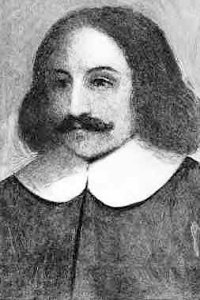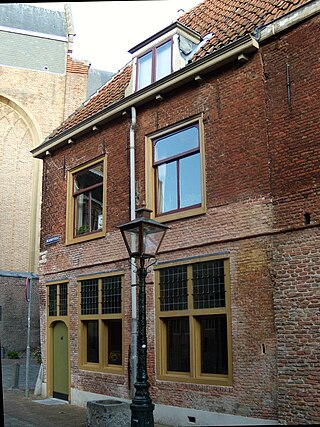
1620 (MDCXX) was a leap year starting on Wednesday of the Gregorian calendar and a leap year starting on Saturday of the Julian calendar, the 1620th year of the Common Era (CE) and Anno Domini (AD) designations, the 620th year of the 2nd millennium, the 20th year of the 17th century, and the 1st year of the 1620s decade. As of the start of 1620, the Gregorian calendar was 10 days ahead of the Julian calendar, which remained in localized use until 1923.

The Pilgrims, also known as the Pilgrim Fathers, were the English settlers who traveled to America on the Mayflower and established the Plymouth Colony in Plymouth, Massachusetts. The Pilgrims' leadership came from the religious congregations of Brownists, or Separatist Puritans, who had fled religious persecution in England for the tolerance of 17th-century Holland in the Netherlands.

Myles Standish was an English military officer and colonist. He was hired as military adviser for Plymouth Colony in present-day Massachusetts, United States by the Pilgrims. Standish accompanied the Pilgrims on the ship Mayflower and played a leading role in the administration and defense of Plymouth Colony from its foundation in 1620. On February 17, 1621, the Plymouth Colony militia elected him as its first commander and continued to re-elect him to that position for the remainder of his life. Standish served at various times as an agent of Plymouth Colony on a return trip to England, as assistant governor of the colony, and as its treasurer.

Plymouth Colony was the first permanent English colony in New England from 1620 to 1691 and the second permanent English colony in America, after the Jamestown Colony. It was settled by the passengers on the Mayflower at a location that had previously been surveyed and named by Captain John Smith. The settlement served as the capital of the colony and developed as the town of Plymouth, Massachusetts. At its height, Plymouth Colony occupied most of the southeastern portion of Massachusetts. Many of the people and events surrounding Plymouth Colony have become part of American folklore, including the American tradition of Thanksgiving and the monument of Plymouth Rock.

William Bradford was an English Puritan Separatist originally from the West Riding of Yorkshire in Northern England. He moved to Leiden in Holland in order to escape persecution from King James I of England, and then emigrated to the Plymouth Colony on the Mayflower in 1620. He was a signatory to the Mayflower Compact and went on to serve as Governor of the Plymouth Colony intermittently for about 30 years between 1621 and 1657. He served as a commissioner of the United Colonies of New England on multiple occasions and served twice as president. His journal Of Plymouth Plantation covered the years from 1620 to 1646 in Plymouth.

John Carver was one of the Pilgrims who braved the Mayflower voyage in 1620 which resulted in the creation of Plymouth Colony in America. He is credited with writing the Mayflower Compact and was its first signer, and he was also the first governor of Plymouth Colony.

Edward Winslow was a Separatist and New England political leader who traveled on the Mayflower in 1620. He was one of several senior leaders on the ship and also later at Plymouth Colony. Both Edward Winslow and his brother, Gilbert Winslow signed the Mayflower Compact. In Plymouth he served in a number of governmental positions such as assistant governor, three times was governor and also was the colony's agent in London. In early 1621 he had been one of several key leaders on whom Governor Bradford depended after the death of John Carver. He was the author of several important pamphlets, including Good Newes from New England and co-wrote with William Bradford the historic Mourt's Relation, which ends with an account of the First Thanksgiving and the abundance of the New World. In 1655 he died of fever while on an English naval expedition in the Caribbean against the Spanish.

William Brewster was an English official and Mayflower passenger in 1620. He became senior elder and the leader of Plymouth Colony, by virtue of his education and existing stature with those immigrating from the Netherlands, being a Brownist.

Christopher Martin and his family embarked on the historic 1620 voyage of the Pilgrim ship Mayflower on its journey to the New World. He was initially the governor of passengers on the ship Speedwell until that ship was found to be unseaworthy, and later on the Mayflower, until replaced by John Carver. He was a signatory to the Mayflower Compact. He and his family all perished in the first winter at Plymouth Colony.
Robert Cushman (1577–1625) was an important leader and organiser of the Mayflower voyage in 1620, serving as Chief Agent in London for the Leiden Separatist contingent from 1617 to 1620 and later for Plymouth Colony until his death in 1625 in England. His historically famous booklet titled 'Cry of a Stone' was written about 1619 and finally published in 1642, many years after his death in 1625. The work is an important pre-sailing Pilgrim account of the Leiden group's religious lives.
John Howland was an English indentured servant who accompanied the English Separatists and other passengers when they left England on the Mayflower to settle in Plymouth Colony. In later years, he was an executive assistant and personal secretary to Governor John Carver.

Master Christopher Jones Jr. was the captain of the 1620 voyage of the Pilgrim ship Mayflower.

John Tilley and his family were passengers on the historic 1620 voyage of the Mayflower. He was a signatory to the Mayflower Compact, and died with his wife in the first Pilgrim winter in the New World.

Humility Cooper, of Leiden, Holland, traveled in 1620 on the voyage of the ship Mayflower as a one-year-old female child in the company of the Edward Tilley family. Although Edward Tilley and his wife died the first winter in the New World, Humility survived to live her young life in Plymouth Colony, returning to England possibly in her teen years. Her fate in England is unknown.

Mayflower was an English ship that transported a group of English families, known today as the Pilgrims, from England to the New World in 1620. After 10 weeks at sea, Mayflower, with 102 passengers and a crew of about 30, reached what is today the United States, dropping anchor near the tip of Cape Cod, Massachusetts, on November 21 [O.S. November 11], 1620.

The Leiden American Pilgrim Museum is a small museum in the Dutch city of Leiden dedicated to the Pilgrim Fathers. These Separatists or English Dissenters were religious refugees who had fled England to Amsterdam in 1608 and moved to Leiden the next year. They lived and worked in that city for about 12 to 20 years. In 1620, their emigration began. They left Leiden by canal, going to Delfshaven where they embarked on the Speedwell, which took them to Southampton. But the Speedwell proved leaky and had to be sold, so they transferred to the Mayflower. The Mayflower undertook the famous voyage to New England in 1620 alone. In the 19th century the colonists' first harvest festival after their arrival at Plymouth Colony was identified as the origin of the annual Thanksgiving celebration in the United States.

John Turner was a passenger, along with his two sons, on the 1620 voyage of the historic Pilgrim ship the Mayflower. He was a signatory to the Mayflower Compact and perished with his sons that first winter.
In the fall of 1621 the Fortune was the second English ship destined for Plymouth Colony in the New World, one year after the voyage of the Pilgrim ship Mayflower. Financed as the Mayflower was by Thomas Weston and others of the London-based Merchant Adventurers, Fortune was to transport thirty-five settlers to the colony on a ship that was much smaller than Mayflower. The Fortune required two months to prepare for the voyage and once underway, reached Cape Cod on 9 November 1621 and the colony itself in late November. The ship was unexpected by those in the Plymouth colony and although it brought useful settlers, many of whom were young men, it brought no supplies, further straining the limited food resources of the colony. The ship only stayed in the colony for about three weeks, returning to England in December loaded with valuable furs and other goods. But when nearing England, instead of heading to the English Channel, a navigation error caused the ship to sail southeast to the coast of France, where it was overtaken and seized by a French warship.

The Mayflower Compact was an iconic document in the history of America, written and signed aboard the Mayflower on November 11, 1620 while anchored in Provincetown Harbor in Massachusetts. The Compact was originally drafted as an instrument to maintain unity and discipline in Plymouth Colony, but it has become one of the most historic documents in American history. It was published in London in Mourt's Relation in 1622, and the authors had added a preamble to clarify its meaning: "it was thought good there should be an association and agreement, that we should combine together in one body, and to submit to such government and governors as we should by common consent agree to make and choose."














